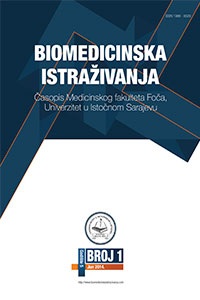Oxidative stress and other risk factors associated with diabetic nephropathy in type 2 diabetes mellitus
DOI:
https://doi.org/10.7251/BII1801027MAbstract
Introduction. The aim of the study was to examine whether biomarkers
of oxidative stress and antioxidant enzyme activities are among other risk
factors for diabetic nephropathy (DN).
Methods. The study involved 70 patients with type 2 diabetes (37 males,
aged 41 to 81 years) allocated to two groups: one of 32 patients with DN
and the other of 38 patients without DN. In the study of oxidative stress 15
healthy persons were included. All examined patients were interviewed and
underwent objective examination. Their serum and urine samples were analyzed
in order to estimate the quality of glycoregulation and kidney function.
Protein thiol groups (P-SH), antioxidant enzyme activities [superoxide
dismutase (SOD) and glutathione peroxidase (GPX)] were determined in
plasma spectrophotometrically and malondialdehyde-adducts (MDA) by
enzyme immunoassay.
Results. No significant differences were found between the two groups
for demographic characteristics, duration and treatment of diabetes, blood
pressure, fasting glucose level and HbA1c. Patients with DN had a higher
body mass index, lower estimated glomerular filtration rate (eGFR) and
higher albuminuria and proteinuria. Plasma activity of GPX and SOD as well
as levels of MDA adducts and P-SH groups were similar in patients with and
without DN, but GPX and SOD plasma activities were significantly lower and
plasma level of MDA significantly higher in all patients than in healthy controls.
Patient gender, age, BMI, HbA1c and plasma level of P-SH and MDA
were selected as significant predictors of DN. Patient age, duration of diabetes,
serum phosphorus, uric acid levels and plasma SOD activity were negatively
associated with eGFR. Patient age, serum levels of protein and albumin
and plasma GPX activity were negatively, while systolic BP, serum levels
of uric acid and cholesterol were positively associated with proteinuria.
Conclusion. Biomarkers of oxidative protein and lipid damage were selected
as risk factors for DN, besides several other well known risk factors.

